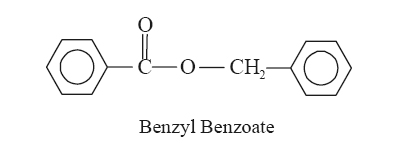A. Benzyl Benzoate
Synonyms Ascabin; Venzonate; Ascabiol.
Chemical Structure Benzoic acid phenyl methyl ester; (C14H12O2).
Occurrence It is contained in Peru and Tolu balsams. It is also found in a variety of volatile oils, such as: Cananga odorata (Lam.) Hook. f. & Thomas (Annonaceae)-Ylang-Ylang, Cananga; Cinnamonum verum J S Presl (Lauraceae)-Ceylon Cinnamon; Myroxylon balsamum Var. Pereirae (Royle) Harms. (Fabaceae)-Balsam of Peru; Peumus boldus Molina (Monimiaceae)-Baldo; Vanilla planifolia Andr. (Orchidaceae)-Vanilla.
Isolation Benzyl benzoate may be isolated by cooling the corresponding fraction to a very low temperature when it gets separated as a solid (mp 21°C). It may also be further recrystallized from chloroform or ether.
Characteristic Features It is an oily liquid or leaflets, having a faint, pleasant aromatic odour. It possesses a sharp burning taste. Its physical characteristics are: mp 21°C; d204 1.118; bp 323-324°C; bp16 189-191°C; bp4.5 156°C, and n21D 1.5681. It is sparingly volatile with steam. It is insoluble in water or glycerol, but miscible with alcohol, chloroform, ether and oils.
Identification The benzyl benzoate on saponification yields the two products of reaction i.e., benzoic acid and benzyl alcohol that may be identified by carrying out specific tests for these compounds.
Uses
1. It is used extensively as a diluent and solvent of solid aromatics e.g., artificial musk.
2. By virtue of its low volatility benzyl benzoate is employed as a fixative in perfume composition.
3. It is used as a solvent for cellulose acetate and nitrocellulose.
4. It serves as a substitute for camphor in celluloid and plastic pyroxylin compounds.
5. It is also employed in confectionery and chewing gum flavours.
Source:Pharmacognosy And Pharmacobiotechnology By Ashutosh Kar
Source:Pharmacognosy And Pharmacobiotechnology By Ashutosh Kar



0 Comment:
Post a Comment